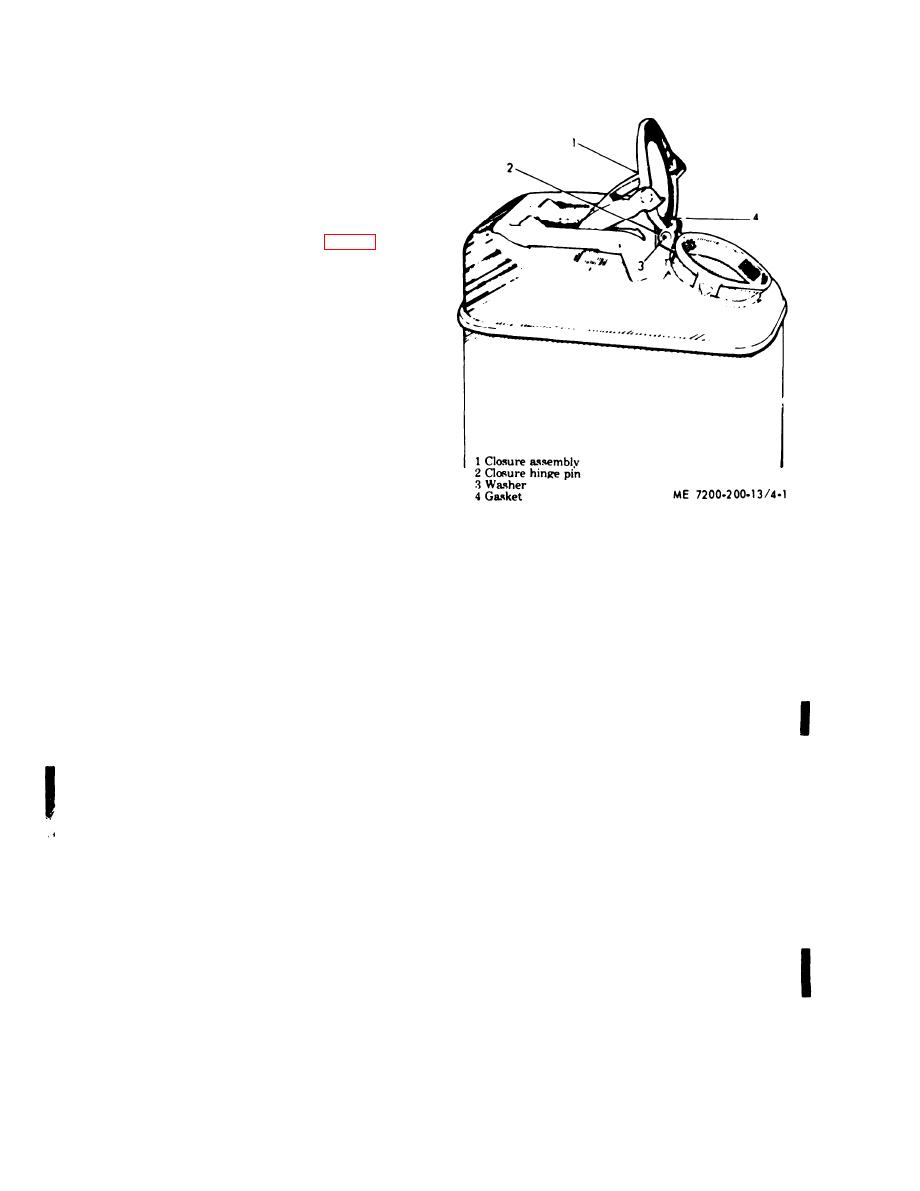 |
|||
|
|
|||
|
Page Title:
Section III. ORGANIZATIONAL MAINTENANCE |
|
||
| ||||||||||
|
|
 TM 10-7200-200-13
Section Ill. ORGANIZATIONAL MAINTENANCE
4-6. Special Tools and Equipment
The five gallon water can does not require special
tools, parts, or equipment.
4-7. Repair
are in good condition. Replace missing or defective
gaskets with new ones. Use only the approved
nontoxic cement (FSN 8040-273-8717).
b. Closure Assembly Replace the closure assembly
(1) when damaged.
c. Replace damaged or worn pin (2) and washer (3).
Use a hammer to peen replacement hinge pin while
holding opposite end of pin in position with another
hammer or suitable tool.
Figure 4-1. Water can, (aluminum, 5-gallon.
Section IV. DIRECT SUPPORT MAINTENANCE
removed. Rinse cans in clean boiling water, turn
4-8. Repair Parts, Special Tools and Equip-
upside down, and allow to dry.
ment
d. Rinsing and Drying. Rinse cans in clean boiling
a. Special Tools and Equipment. The five gallon
water. Turn upside down to dry.
water can does not require special tools and
e. Replacing Parts. Install new gasket and replace
equipment.
closure assembly, pin, and washer when parts are
b. Repair Pants. Repair parts issued with or
worn or damaged.
authorized for the five gallon gasoline can are listed
f. Leak Testing. Before the cans are painted they
in the Repair Parts List, Section VI.
will be tested for leaks. Cans with leaks in the body of
4-9. Refinishing
the can will be scrapped. The presence of leaks can be
determined by either of the following tests:
a. Removing Dents. No attempt will be made to
(1) Water tank test. Cans are subjected to internal
remove dents from cans. Dents in cans are accepta-
air pressure and completely submerged in clean
ble providing the cans are not ruptured and do not
water. Air bubbles emitted from cans indicate the
repair stacking.
presence and location of leaks.
b. Cleaning Exterior. Flanges and plugs, especially
(2) Air pressure test. Cans are subjected to
threads and gasket seats, must be thoroughly
internal air pressure of 7-to 9-psi for a period of 45
cleaned. Clean flanges and plugs and remove all
seconds. A drop in air pressure, as indicated in an
corrosion and other foreign matter. All gaskets
accurate pressure gage during the test period, shows
should be removed before cans are cleaned. All loose
the presence of leaks.
paint,. grease, and other foreign matter will be
removed from the exterior of the can. This can be
g. Repairing Leaky Cans. Cans with leaks in the
done by chemical or mechanical means.
body of the can will be scrapped, closure assembly .
c. Cleaning Interior. Cans will be thoroughly
leaks will be repaired.
h. Painting Exterior. After cans have been
cleaned by washing in hot water containing a
repaired, thoroughly cleaned, leak tested, and dried,
hand-dishwashing compound, P-D410. Repeat this
exteriors will be painted with enamel, TT-E-529.
until all loose scale or other foreign matter is
4-2 Change 1
|
|
Privacy Statement - Press Release - Copyright Information. - Contact Us |